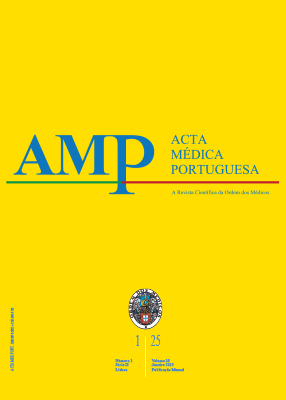Infeções Associadas aos Cuidados de Saúde em Idade Pediátrica: 10 Anos de Experiência num Serviço de Cuidados Intensivos
DOI:
https://doi.org/10.20344/amp.22279Palavras-chave:
Criança, Cuidados Intensivos, Infeção Hospitalar, Resistência Microbiana a Medicamentos, Unidades de Cuidados Intensivos PediátricosResumo
Introdução: As infeções associadas aos cuidados de saúde são uma causa importante de morbimortalidade na população pediátrica, representando um problema crescente nos serviços de cuidados intensivos. Contudo, existem poucos estudos que caracterizam a realidade destas infeções na população pediátrica portuguesa. Este estudo pretendeu avaliar a sua prevalência num serviço de cuidados intensivos pediátrico português, identificando os microrganismos mais frequentes e o respetivo perfil de resistência aos antibióticos.
Métodos: Estudo de coorte retrospetivo que incluiu os doentes admitidos num serviço de cuidados intensivos pediátrico entre 1 de janeiro de 2014 e 31 de dezembro de 2023, com diagnóstico de infeções associadas aos cuidados de saúde durante o internamento.
Resultados: Identificaram-se 248 casos, correspondendo a uma prevalência de 6,3%, a maioria em lactentes. As infeções mais frequentes foram
pneumonia (45,2%) e bacteriemia (14,5%), sendo os agentes infeciosos mais comuns os Gram negativos, nomeadamente a Escherichia coli, a Pseudomonas
aeruginosa e a Klebsiella pneumoniae. Observou-se um aumento global das resistências antibióticas nos últimos cinco anos (2019 - 2023). A taxa de infeção por bactérias produtoras de ESBL, MRSA e ERC foi, respetivamente, 8,5%, 1,6% e 0,4%, superior nos anos 2019 - 2023. Houve 45 colonizações em 41 doentes (num total de 97 pesquisas realizadas): 40 a ESBL e 5 a ERC (sem colonizações por MRSA). A sépsis ocorreu em 29,8% casos e a mortalidade foi de 11,7% (4,0% devido à IACS). A exposição a tubo endotraqueal e a ventilação invasiva de longa duração associaram-se
a maior probabilidade de desenvolver pneumonia (OR = 2,5; IC 95%, 1,1 a 5,9; p = 0,03; e OR = 1,9; IC 95%, 1,1 a 3,4; p = 0,011; respetivamente).
Conclusão: É fundamental implementar estratégias eficazes para prevenir e controlar a disseminação das bactérias resistentes, assegurando a eficácia das terapêuticas atuais, a segurança dos doentes e a proteção da saúde pública.
Downloads
Referências
Su C, Zhang Z, Zhao X, Peng H, Hong Y, Huang L, et al. Changes in prevalence of nosocomial infection pre- and post-COVID-19 pandemic from a tertiary Hospital in China. BMC Infect Dis. 2021;21:693.
Murni IK, Duke T, Kinney S, Daley AJ, Soenarto Y. Reducing hospitalacquired infections and improving the rational use of antibiotics in a developing country: an effectiveness study. Arch Dis Child. 2015;100:454-9.
Chen YC, Lin CF, Rehn YF, Chen JC, Chen PY, Chen CH, et al. Reduced nosocomial infection rate in a neonatal intensive care unit during a 4-year surveillance period. J Chin Med Assoc. 2017;80:427-31.
Izadi N, Eshrati B, Mehrabi Y, Etemad K, Hashemi-Nazari SS. The national rate of intensive care units-acquired infections, one-year retrospective study in Iran. BMC Public Health. 2021;21:609.
Aktar F, Tekin R, Güneş A, Ülgen C, Tan I, Ertuğrul S, et al. Determining the independent risk factors and mortality rate of nosocomial infections in pediatric patients. Biomed Res Int. 2016;2016:7240864.
Wang L, Du KN, Zhao YL, Yu YJ, Sun L, Jiang HB. Risk factors of nosocomial infection for infants in neonatal intensive care units: a systematic review and meta-analysis. Med Sci Monit. 2019;25:8213-20.
Rangelova V, Kevorkyan A, Raycheva R, Krasteva M. Ventilatorassociated pneumonia in the neonatal intensive care unit-incidence and strategies for prevention. Diagnostics. 2024;14:240.
Adams-Chapman I, Stoll BJ. Prevention of nosocomial infections in the neonatal intensive care unit. Curr Opin Pediatr. 2002;14:157-64.
Walek KW, Leary OP, Sastry R, Asaad WF, Walsh JM, Horoho J, et al. Risk factors and outcomes associated with external ventricular drain infections. Infect Control Hosp Epidemiol. 2022;43:1859-66.
Sahiledengle B, Seyoum F, Abebe D, Geleta EN, Negash G, Kalu A, et al. Incidence and risk factors for hospital-acquired infection among paediatric patients in a teaching hospital: a prospective study in southeast Ethiopia. BMJ Open. 2020;10:e037997.
Suetens C, Latour K, Kärki T, Ricchizzi E, Kinross P, Moro ML, et al. Prevalence of healthcare-associated infections, estimated incidence and composite antimicrobial resistance index in acute care hospitals and long-term care facilities: results from two European point prevalence surveys, 2016 to 2017. Euro Surveill. 2018;23:1800516.
Morillo-García Á, Aldana-Espinal JM, Olry de Labry-Lima A, Valencia- Martín R, López-Márquez R, Loscertales-Abril M, et al. Hospital costs associated with nosocomial infections in a pediatric intensive care unit. Gac Sanit. 2015;29:282-7.
Afsharipour M, Mahmoudi S, Raji H, Pourakbari B, Mamishi S. Threeyear evaluation of the nosocomial infections in pediatrics: bacterial and fungal profile and antimicrobial resistance pattern. Ann Clin Microbiol Antimicrob. 2022;21:6.
Cassini A, Högberg LD, Plachouras D, Quattrocchi A, Hoxha A, Simonsen GS, et al. Attributable deaths and disability-adjusted lifeyears caused by infections with antibiotic-resistant bacteria in the EU and the European Economic Area in 2015: a population-level modelling analysis. Lancet Infect Dis. 2019;19:56-66.
Direção-Geral da Saúde. Prevenção e controlo de colonização e infeção por Staphylococcus aureus resistente à meticilina (MRSA) nos hospitais e unidades de internamento de cuidados continuados integrados. Norma n.º 018/2014. Lisboa:DGS; 2015.
Direção-Geral da Saúde. Avaliação de risco e rastreio de Enterobacterales produtores de carbapenemases (EPC) e de Staphylococcus aureus resistente a meticilina (SAMR) à admissão hospitalar e durante o internamento. Norma n.º 004/2023. Lisboa: DGS; 2023.
Schlapbach LJ, Watson RS, Sorce LR, Argent AC, Menon K, Hall MW, et al. International consensus criteria for pediatric sepsis and septic shock. Jama. 2024;331:665-74.
Sahetya S, Allgood S, Gay PC, Lechtzin N. Long-term mechanical ventilation. Clin Chest Med. 2016;37:753-63.
Trudzinski FC, Michels-Zetsche JD, Neetz B, Meis J, Müller M, Kempa A, et al. Risk factors for long-term invasive mechanical ventilation: a longitudinal study using German health claims data. Respiratory Research. 2024;25:60.
Teixeira H, Freitas A, Sarmento A, Nossa P, Gonçalves H, Pina MF. Spatial patterns in hospital-acquired infections in Portugal (2014-2017). Int J Environ Res Public Health. 2021;18:4703.
Andrade MH. Infeções Associadas aos cuidados de saúde numa unidade de cuidados intensivos pediátricos. Estudo comparativo 2013- 2020. Lisboa: Faculdade de Medicina da Universidade de Lisboa; 2021.
Uc-Cachón AH, Gracida-Osorno C, Luna-Chi IG, Jiménez-Guillermo JG, Molina-Salinas GM. High prevalence of antimicrobial resistance among gram-negative isolated bacilli in intensive care units at a tertiarycare hospital in Yucatán Mexico. Medicina. 2019;55:588.
European Centre for Disease Prevention and Control. Healthcareassociated infections acquired in intensive care units. Annual Epidemiological Report for 2020. 2024. [consultado 2024 jun 12]. Disponível em: https://www.ecdc.europa.eu/sites/default/files/ documents/healthcare-associated-infections-intensive-care-unitsannual- epidemiological-report-2020.pdf.
Basnet S, Adhikari S, Jha J, Pandey MR. Neonatal intensive care unit admissions among preterm babies in a tertiary care centre: a descriptive cross-sectional study. JNMA J Nepal Med Assoc. 2022;60:364-8.
Wasniewski AB, Ricachinevsky CP, Rezende RQ, Lorentz BT, Silveira ES, Angeli VH, et al. Adverse events in the postoperative period of cardiac surgery in a pediatric intensive care unit: the contribution of the VIS score and the RACHS-1. Crit Care Sci. 2023;35:377-85.
Alten JA, Rahman A, Zaccagni HJ, Shin A, Cooper DS, Blinder JJ, et al. The epidemiology of healthcare-associated infections in pediatric cardiac intensive care units. Pediatr Infect Dis J. 2018;37:768-72.
van Hasselt TJ, Webster K, Gale C, Draper ES, Seaton SE. Children born preterm admitted to paediatric intensive care for bronchiolitis: a systematic review and meta-analysis. BMC Pediatr. 2023;23:326.
Brandi S, Troster EJ, Cunha M. Length of stay in pediatric intensive care unit: prediction model. Einstein. 2020;18:eAO5476.
Haque M, Sartelli M, McKimm J, Abu Bakar M. Health care-associated infections - an overview. Infect Drug Resist. 2018;11:2321-33.
Mohamed HT, Farhan Alenezi WA, Sr., Alanzi MA, Saleh Alsuqub FI, Salem Alhazmi SA, Mohammed Alhazmi OM. Prevalence of ventilatorassociated pneumonia in children admitted to pediatric intensive care units in the middle east: a systematic review. Cureus. 2023;15:e51230.
Torre FP, Baldanzi G, Troster EJ. Risk factors for vascular catheterrelated bloodstream infections in pediatric intensive care units. Rev Bras Ter Intensiva. 2018;30:436-42.
Pitiriga V, Kanellopoulos P, Bakalis I, Kampos E, Sagris I, Saroglou G, et al. Central venous catheter-related bloodstream infection and colonization: the impact of insertion site and distribution of multidrugresistant pathogens. Antimicrob Resist Infect Control. 2020;9:189.
Yamaguchi RS, Noritomi DT, Degaspare NV, Muñoz GO, Porto AP, Costa SF, et al. Peripherally inserted central catheters are associated with lower risk of bloodstream infection compared with central venous catheters in paediatric intensive care patients: a propensity-adjusted analysis. Intensive Care Med. 2017;43:1097-104.
Kohbodi GA, Rajasurya V, Noor A. Ventilator-associated pneumonia. In: StatPearls. Treasure Island: StatPearls Publishing LLC; 2024.
Kepenekli E, Soysal A, Yalindag-Ozturk N, Ozgur O, Ozcan I, Devrim I, et al. Healthcare-associated infections in pediatric intensive care units in Turkey: a national point-prevalence survey. Jpn J Infect Dis. 2015;68:381-6.
Balkhy HH, El-Saed A, AlShehri A, Alshaalan M, Hijazi O, El-Metwally A, et al. Antimicrobial consumption in three pediatric and neonatal intensive care units in Saudi Arabia: 33-month surveillance study. Ann Clin Microbiol Antimicrob. 2019;18:20.
Tribble AC, Lee BR, Flett KB, Handy LK, Gerber JS, Hersh AL, et al. Appropriateness of antibiotic prescribing in united states children’s hospitals: a national point prevalence survey. Clin Infect Dis. 2020;71:e226-34.
van Wyk L, Applegate JT, Salie S. Ventilator-associated pneumonia in PICU - how are we doing? South Afr J Crit Care. 2022;38:10.
Ruvinsky S, Voto C, Roel M, Deschutter V, Ferraro D, Aquino N, et al. Carbapenem-resistant enterobacteriaceae bloodstream infections: a case-control study from a pediatric referral hospital in Argentina. Front Public Health. 2022;10:983174.
Kannan A, Pratyusha K, Thakur R, Sahoo MR, Jindal A. Infections in critically ill children. Indian J Pediatr. 2023;90:289-97.
Barbier F, Pommier C, Essaied W, Garrouste-Orgeas M, Schwebel C, Ruckly A, et al. Colonization and infection with extended-spectrum β-lactamase-producing enterobacteriaceae in ICU patients: what impact on outcomes and carbapenem exposure? J Antimicrob Chemother. 2016;71:1088-97.
Brissaud O, Guichoux J, Harambat J, Tandonnet O, Zaoutis T. Invasive fungal disease in PICU: epidemiology and risk factors. Ann Intensive Care. 2012;2:6.
Hofmann P, Alabi A, Manouana GP, Onwugamba FC, Hasenauer A, Agbanrin MD, et al. High ESBL-E colonization rate among children in Gabon: a follow-up study. J Med Microbiol. 2021;70.
Borg R, Pace D. MRSA colonisation rates on a neonatal and paediatric intensive care unit. J Infect Prev. 2020;21:68-71.
Horowitz IN, Baorto E, Cirillo T, Davis J. Methicillin-resistant staphylococcus aureus colonization in a pediatric intensive care unit: risk factors. Am J Infect Control. 2012;40:118-22.
Arora HS, Khan H, Ailumerab H, Natarajan G, Meert K, Salimnia H, et al. A tale of two intensive care units (ICUs): baseline staphylococcus aureus colonization and mupirocin susceptibility in neonatal and pediatric patients requiring intensive care. Infect Control Hosp Epidemiol. 2023;44:447-52.
Fasciana T, Antonelli A, Bianco G, Lombardo D, Codda G, Roscetto E, et al. Multicenter study on the prevalence of colonization due to carbapenem-resistant enterobacterales strains before and during the first year of COVID-19, Italy 2018-2020. Front Public Health. 2023;11:1270924.
Instituto Nacional de Estatística. Censos 2021. XVI Recenseamento Geral da População. VI Recenseamento Geral da Habitação: Resultados definitivos. Lisboa: INE; 2021.
Downloads
Publicado
Como Citar
Edição
Secção
Licença
Direitos de Autor (c) 2024 Acta Médica Portuguesa

Este trabalho encontra-se publicado com a Creative Commons Atribuição-NãoComercial 4.0.
Todos os artigos publicados na AMP são de acesso aberto e cumprem os requisitos das agências de financiamento ou instituições académicas. Relativamente à utilização por terceiros a AMP rege-se pelos termos da licença Creative Commons ‘Atribuição – Uso Não-Comercial – (CC-BY-NC)’.
É da responsabilidade do autor obter permissão para reproduzir figuras, tabelas, etc., de outras publicações. Após a aceitação de um artigo, os autores serão convidados a preencher uma “Declaração de Responsabilidade Autoral e Partilha de Direitos de Autor “(http://www.actamedicaportuguesa.com/info/AMP-NormasPublicacao.pdf) e a “Declaração de Potenciais Conflitos de Interesse” (http://www.icmje.org/conflicts-of-interest) do ICMJE. Será enviado um e-mail ao autor correspondente, confirmando a receção do manuscrito.
Após a publicação, os autores ficam autorizados a disponibilizar os seus artigos em repositórios das suas instituições de origem, desde que mencionem sempre onde foram publicados e de acordo com a licença Creative Commons









